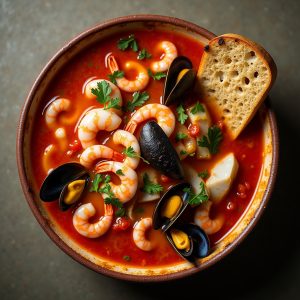
AI generated image
Chef's Tip
Add the seafood to your stew in order of cooking time—clams and mussels first, followed by firm white fish, then shrimp, and finally calamari which needs just seconds to cook. This staged approach ensures each type of seafood is perfectly cooked and not rubbery or tough.
Instructions
- Heat olive oil in a large Dutch oven or heavy-bottomed pot over medium heat. Add onion and fennel, season with salt, and cook until softened, about 5-7 minutes.
- Add garlic and red pepper flakes and cook until fragrant, about 1 minute, being careful not to brown the garlic.
- Pour in the white wine and bring to a simmer. Let reduce by half, about 3-4 minutes.
- Add crushed tomatoes, fish stock, bay leaves, and thyme bundle. Season with salt and black pepper. Bring to a simmer and cook for 15 minutes to allow flavors to meld.
- Add clams and mussels to the pot, cover, and cook for about 3-4 minutes until they begin to open.
- Add the chunks of fish and cook for 2 minutes.
- Add the shrimp and cook for another 2 minutes.
- Finally, add the calamari and cook for just 1 minute more. Remove from heat.
- Discard any clams or mussels that haven't opened, as well as the bay leaves and thyme bundle.
- Stir in half of the chopped parsley and all of the torn basil.
- Taste the broth and adjust seasoning with salt and pepper as needed.
Plating
Ladle the stew into warm, shallow bowls, ensuring each serving gets a variety of seafood. Arrange the shellfish attractively on top. Sprinkle with remaining parsley and serve with lemon wedges and slices of crusty Italian bread for dipping in the flavorful broth.
Storage & Reheating
Seafood stew is best consumed immediately after cooking. If you must store leftovers, refrigerate in an airtight container for up to 2 days. Reheat gently on the stovetop just until warmed through to avoid overcooking the seafood. Note that the texture of the seafood may change slightly upon reheating.
About This Recipe
Biba's Zuppa di Pesce was a celebration of New England's fresh seafood prepared with Italian coastal traditions. This adaptation honors the restaurant's commitment to cooking each seafood component to perfection, while maintaining the rich, aromatic broth that made the dish memorable. The combination of tomatoes, white wine, and herbs creates an ideal backdrop for showcasing the natural flavors of the sea.
